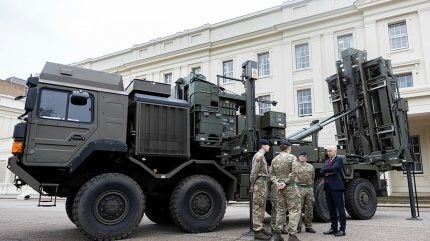World
UK Enhances Air Defence with Six New Land Ceptor Systems

The UK Ministry of Defence has announced a significant enhancement to its air and missile defence capabilities with the acquisition of six new Land Ceptor systems. This purchase, valued at £118 million (approximately $158 million), is part of a three-year contract with MBDA, a leading European complex weapons manufacturer. The decision, confirmed in a government statement on 22 August 2023, aims to double the number of deployable air defence units available on British soil.
Details of the Land Ceptor System
Land Ceptor is a versatile missile launcher designed to operate independently or as part of the medium-range Sky Sabre ground-based air defence (GBAD) system. This advanced missile system is complemented by Saab’s Giraffe 1X radar and Rafael’s Surface-to-Air Missile Centre for command and control. The Land Ceptor is engineered to intercept a range of aerial threats, including aircraft, cruise missiles, and uncrewed aerial systems. Remarkably, it can simultaneously control the flight of up to 24 missiles, guiding each one to intercept different targets.
The system serves as a rapidly deployable point and area defence mechanism, crucial for protecting both mobile and static high-value assets using Common Anti-Air Modular Missiles (CAMM). The new units will create approximately 140 jobs and bolster the manufacturing capabilities at MBDA UK’s facility in Bolton, Lancashire.
Current Air Defence Landscape
Presently, the UK deploys seven Sky Sabre systems operated by the 16 Regiment Royal Artillery under the 7 Air Defence Group. Two of these units are stationed in the Falkland Islands, while the remaining five are based at Baker Barracks on Thorney Island in West Sussex. Until recently, the UK had only four operational units on home soil. One of these units was reassigned to Poland in December 2024 to support NATO allies following Russia’s invasion of Ukraine in April 2022.
The UK government has stated that the Sky Sabre system will be exchanged for an unspecified number of Typhoon aircraft to further enhance security in Polish airspace. This shift underscores the UK’s commitment to supporting its allies while addressing its own air defence needs.
Despite these advancements, some analysts express concern over the limited number of medium-range systems available to the UK. Calls for the development of a comprehensive missile defence shield, similar to Israel’s Iron Dome, have emerged. Others advocate for more targeted measures, suggesting that resources should focus on protecting major population centres and critical national infrastructure, which might prove more feasible for a financially constrained government.
Recognising the urgency of enhancing air defence capabilities, the UK government has committed to investing £1 billion in integrated air and missile defence (IAMD), as recommended in the Strategic Defence Review (SDR) released on 2 June. Although the SDR did not specify the focus areas for this investment, a Defence Investment Plan is expected to be completed in the autumn, potentially providing further clarity on the government’s strategic direction.
As the UK moves forward with its air defence enhancements, the introduction of the Land Ceptor systems represents a critical step in bolstering national security and addressing evolving global threats.
-

 Entertainment3 months ago
Entertainment3 months agoAnn Ming Reflects on ITV’s ‘I Fought the Law’ Drama
-

 Entertainment4 months ago
Entertainment4 months agoKate Garraway Sells £2 Million Home Amid Financial Struggles
-

 Health3 months ago
Health3 months agoKatie Price Faces New Health Concerns After Cancer Symptoms Resurface
-

 Entertainment3 months ago
Entertainment3 months agoCoronation Street’s Carl Webster Faces Trouble with New Affairs
-

 Entertainment3 months ago
Entertainment3 months agoWhere is Tinder Swindler Simon Leviev? Latest Updates Revealed
-

 World2 weeks ago
World2 weeks agoBailey Announces Heartbreaking Split from Rebecca After Reunion
-

 Entertainment2 weeks ago
Entertainment2 weeks agoCoronation Street Fans React as Todd Faces Heartbreaking Choice
-

 Entertainment4 months ago
Entertainment4 months agoMarkiplier Addresses AI Controversy During Livestream Response
-

 Science1 month ago
Science1 month agoBrian Cox Addresses Claims of Alien Probe in 3I/ATLAS Discovery
-

 Health5 months ago
Health5 months agoCarol Vorderman Reflects on Health Scare and Family Support
-

 Entertainment4 months ago
Entertainment4 months agoKim Cattrall Posts Cryptic Message After HBO’s Sequel Cancellation
-

 Entertainment3 months ago
Entertainment3 months agoOlivia Attwood Opens Up About Fallout with Former Best Friend








